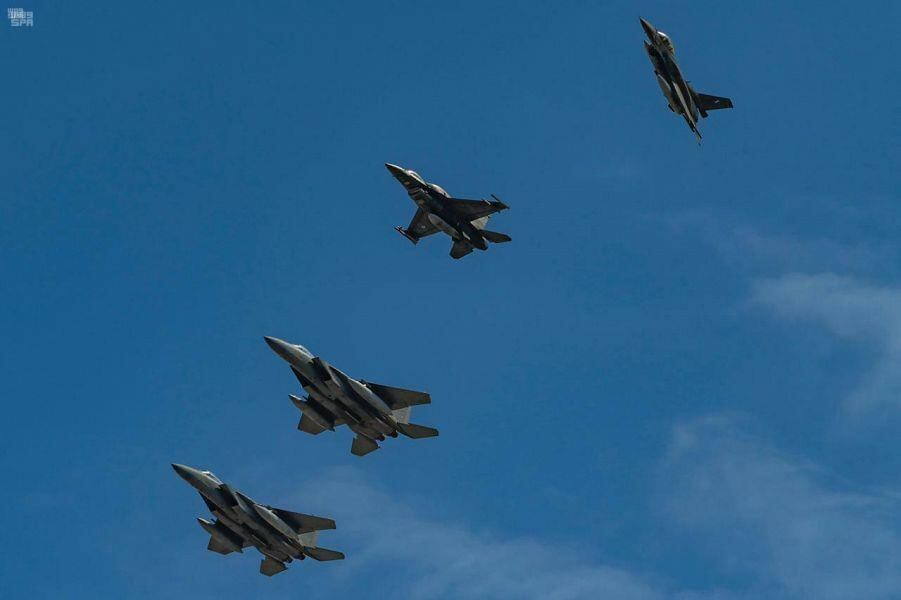Greece hosted the Iniochos 2021 military exercise in April, welcoming military forces from the United States, Israel, the United Arab Emirates, Cyprus and a number of other nations. In addition to improving military readiness and strengthening the ability of the respective militaries to work together, the exercise sent an unmistakable message to Iran that it has failed to isolate Israel.
The Hellenic Air Force-led annual military exercise ran from April 12 to 22 and focused on planning and conducting a number of tactical and operational air combat missions. These included “a multitude of joint operations and air defense training to include air-to-ground strike missions, defensive counter-air and close air support,” according to the U.S. Air Force. The exercise was conducted in Greek airspace over western and central Greece as well as over the central and southeastern Aegean Sea.
To conduct this training, the participating nations brought a robust array of military aircraft. The Greek hosts utilized their F-16, F-4, and Mirage 2000 and 2000-5 fighters. The U.S. contingent included F-16s from the 31st Fighter Wing based in Aviano, Italy, KC-135 tankers based in the United Kingdom, and MQ-9 Reaper remotely piloted aircraft based in Romania.
The American F-16s were busy during the exercise, dropping approximately 170 inert munitions, firing 8,300 training rounds and completing more than 200 sorties. American joint terminal attack controllers — Air Force personnel who maneuver with ground forces and coordinate close-air support — also traveled from Vilseck, Germany, to participate in the exercise and work with partner nations.
Both Israel and the United Arab Emirates brought American-made fighters to the exercise. The Israeli contingent included F-15Is and F-16Is as well as refueling tankers and G550 surveillance aircraft. The United Arab Emirates, for its part, sent F-16s. French M-2000D fighters, Spanish EF-18 fighters and Cypriot AW139 helicopters also participated. Notably, Egypt and Jordan were among five nations welcomed by Greece to officially observe the exercise.

After reviewing these details regarding the exercise in Greece, many might understandably think of Turkey first. Under President Recep Tayyip Erdogan, after all, Ankara has pursued an increasingly hostile posture toward Cyprus, Israel, Greece and the United States. In addition to acquiring the S-400 air defense system from Russia — the leading threat to the NATO alliance — Erdogan has engaged in gunboat diplomacy to challenge maritime borders.
Besides grabbing the attention of Erdogan, leaders in Tehran surely took note of the exercise, too. For decades, Tehran has tried to stoke division between Arabs and Jews to divide the Islamic Republic’s adversaries and isolate Israel. Even as it funds terrorist organizations such as Hamas and Hezbollah, Tehran has attempted to perpetuate the myth that Israel — not the Islamic Republic of Iran — represents the true threat to regional security.
Arab leaders have long known the truth privately, often because Tehran made them targets of its sabotage and subversion. But last year, the United Arab Emirates and Bahrain normalized relations with Israel as part of the historic Abraham Accords, matching private understanding with public action. That has opened a flood of mutually beneficial opportunities for Israel and the United Arab Emirates. One of those is to build a more diplomatically unified and militarily capable coalition to oppose aggression from Tehran and its terror proxies.
RELATED

That is what makes the presence of Israeli and Emirati pilots and aircraft at the Iniochos exercise so notable. While Israel and the United Arab Emirates have participated in the exercise before, this year’s iteration is the first following the 2020 Abraham Accords.
As recently as 2018, some apparently took efforts to hide Israel’s participation in the exercise, perhaps wanting to avoid any awkwardness with the United Arab Emirates. Not so this year, with Israelis playing a prominent role in the exercise alongside their Emirati counterparts.
A source familiar with the exercise reported that “there was excellent cooperation among all participating countries during the exercise.” That’s bad news for leaders in Tehran.
Following the Abraham Accords, the involvement of Israeli and Emirati forces in the Iniochos exercise creates an excellent foundation to deepen and expand military training and exercises between Israel and a growing number of Arab partners.
As possible next steps, perhaps Greece could invite Egypt and Jordan to join Israel, the United Arab Emirates and others as full participants in the next exercise. The United Arab Emirates should consider inviting Israel to join the United States in the next iteration of the UAE-hosted Iron Union exercise. Washington should also look to expand American, Arab and Israeli combined training opportunities in the United States.
These and related steps will help build a more unified and capable military deterrent to Tehran’s aggression.
Bradley Bowman is senior director of the Center on Military and Political Power at the Foundation for Defense of Democracies, where Ryan Brobst is a research analyst.








